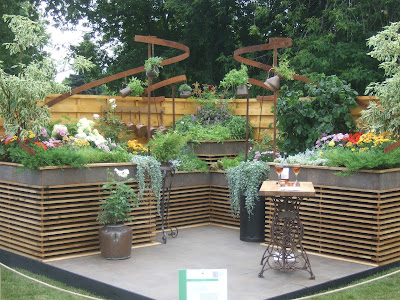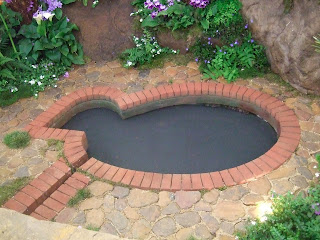Flowers, herbs and vegetables fill the large raised beds arranged at angle in the small garden presented by Caspian Robertson, Surrey Gardens, at the Moscow Flower Show 2013, A la Mode Dining. Two shrubs give height at the opposite sides of the structure, whose wood panels in the back echo the thin layers made of oak of the beds. From these, two iron spirals rise as decorative elements and practical supports to hang pots. In the front, a small table with two glasses of wine expresses the full potentialities of the garden better than many words: the pleasure of gardening, the joy of harvesting and the pride of cooking and eating home grown products in a beautiful setting. The idea is nicely supported: the list of the vegetables and herbs cultivated is available with the menu especially created with them by the famous chef Jean-Christophe Novelli. But, the list is just a suggestion, an open invitation to experiment with flowers and recipes in a daily contact with nature.
 |
| A la Mode Dining, design. |
 |
| Caspian Robertson, A la Mode Dining Garden |
TravelinaGarden: A la Mode Dining is a contemporary garden suitable for a corner in New York as well as in Paris or in Stockholm. According to your experience in Russia, which elements would you change, in the selection of plants or in the decorative elements, to make it more "Russian"?
Caspian Roberston: Where as the design remained constant the planting has heavily adapted for the Moscow show. This was a necessity due to the sever winters experienced in Russia compared with the temperate conditions of the UK. There are some exceptions to this, such as a selection of the David Austin Roses that where selected for there hardiness, "Munstead Wood" is a particularly good example of this, which boasts a fantastic fragrance.
The planting was also changed to better fit with the Russian preference for bright, sharply contrasting colours as opposed to the more reserved pallets that are very much in vogue in the UK at the moment.
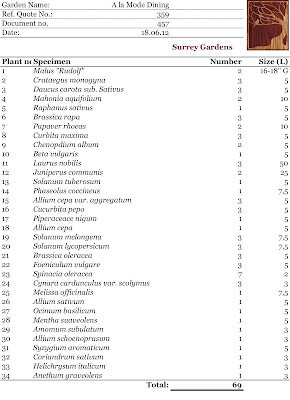 |
| Plant List |
Caspian Robertson: The garden was first built for an Autumn Exhibit, thus heavily made use of fruits, vegetables and other autumn produce. (see attached plant-list and photo). I have always preferred planting to encompass herbaceous perennials and deciduous shrubs, as well as a wide a season of flowering interest as possible. This not only extends the time for which the garden looks inviting for visitors but also better provides for pollinating insects.
Naturally, for the purposes of a show the planting is somewhat biased towards the show dates!
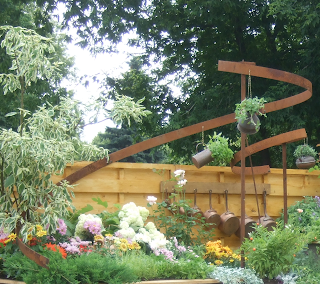 TravelinaGarden: In your garden, nature is beauty, pleasure and something useful and necessary. Quoting Fibonacci and his Golden Ratio, which aspect of nature you wanted to stress and why?
TravelinaGarden: In your garden, nature is beauty, pleasure and something useful and necessary. Quoting Fibonacci and his Golden Ratio, which aspect of nature you wanted to stress and why? Caspian Roberston: It was the classical philosophers of ancient Greece that first recognised that nature is intrinsically connected with mathematics, music and the arts. Indeed they did not distinguish between art and science, which I largely believe is a healthy stance to adopt whist in the creative process.
It is, therefore, no coincidence that the Fibonacci sequence and golden ratio -which is found throughout the natural world - is considered so appeasing to the eye by artists and architects alike. Its use in the garden was a recognition of its role in plant physiology as well as a means of enjoying the inherent beauty of its form.
 |
| Fibonacci's Spiral |
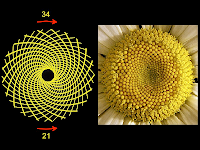 |
| Fibonacci numbers in sun flower |
TravelinaGarden: What are your projects for the next future?
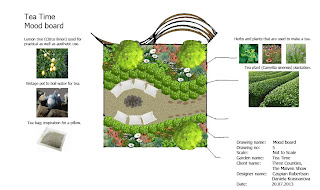 |
| The Tregothnan Tea Garden, Mood Board. |
Caspian Robertson: Immediately after the Moscow show I was building a show garden at the Royal Horticultural Society's Hampton Court Palace Flower Show, where I won a Silver Flora Medal for "Bugs in Boots", an ecological garden for insects that preserves rain water. This has led to a very interesting design in Saudi Arabia which is taking most of my time theses days. I will then be re-building Bugs in Boots for someone who bought it after the show right after my next show garden: "The Tregothnan Tea Garden", which I will be exhibiting at the RHS's Malvern Autumn Show.
Hopefully then I shall have a few weeks to start preparing another garden for the Moscow Flower Show 2014!
Photos:
TravelinaGarden, Moscow, June 2013, except for:
A la Mode Dining, design, from the official presentation.
Caspian Robertson, A la Mode Dining Garden, Plant List and The Tregothnan Tea Garden, Mood Board, Caspian Robertson.
Fibonacci's Spiral, from: http://www.atuttoportale.it/didattica/botanica/botanica.aspx.
Fibonacci numbers in sun flower, from: http://news.softpedia.com/newsImage/The-Numbers-of-Fibonacci-and-Nature-2.jpg/
Link:
Caspian Robertson Surrey Gardens
Shelley's Barn, The Old Farmhouse
Hermongers, Rudgwick, West Sussex RH12 3 AL
01403 824034 07980 554010
www.SurreyGardens.org
Jean-Christophe Novelli
www.jeanchristophenovelli.com
